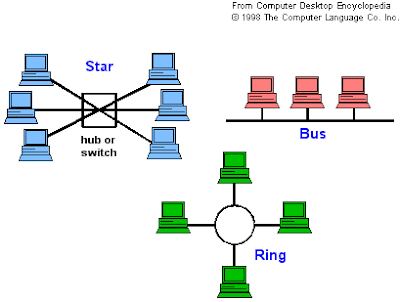
Ring topology: As the name implies, in a ring topology all the devices on a network are connected in the form of a ring or circle. This topic describes a ring topology.
Unlike thephysical Bus Topology , a ring type of topology has no beginning or end that needs to be terminated. Data is transmitted in a way that is very different from the logical bus topology. In one implementation, a “token” travels around the ring, stopping at each device. If a device wants to transmit data, it adds that data and the destination address to the token. The token then continues around the ring until it finds the destination device, which takes the data out of the token. The advantage of using this type of method is that there are no collisions of data packets. There are two types of ring topology: single-ring and dual-ring.
Star topology: The star topology is the most common physical topology in Ethernet LANs. This topic describes both the star and extended-star topologies. When installed, the star topology resembles spokes in a bicycle wheel. It is made up of a central connection point that is a device, such as a hub, switch, or router, where all the cabling segments actually meet. Each device on the network is connected to the central device with its own cable.
Bus topology: A bus topology connects each computer (nodes) to a single segment trunk (a communication line, typically coax cable, that is referred to as the 'bus'. The signal travels from one end of the bus to the other. A terminator is required at each to absorb the signal so as it does not reflect back across the bus. A media access method called CSMA/MA is used to handle the collision that occur when two signals placed on the wire at the same time. The bus topology is passive. In other words, the computers on the bus simply 'listen' for a signal; they are not responsible for moving the signal along.

No comments:
Post a Comment